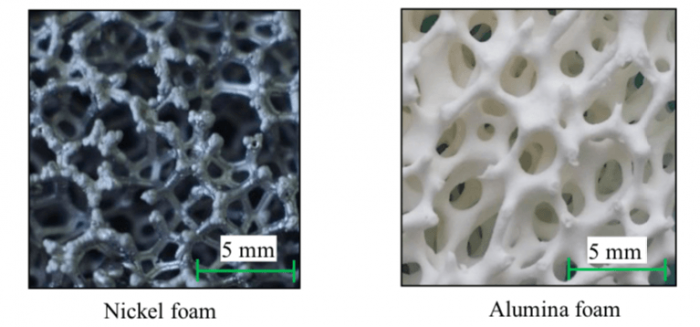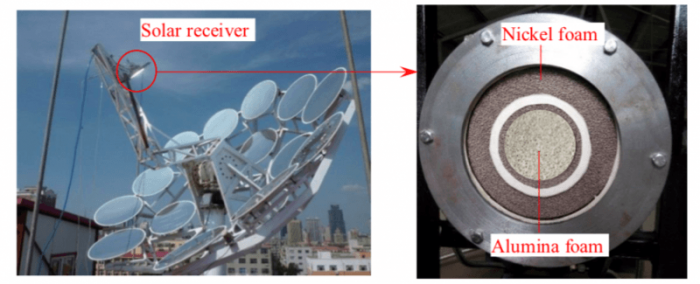
Open-cell materials, such as metal and ceramic foams, have been extensively utilized in high-temperature applications due to their light weight, good flow-mixing capability, and ability to cover a large surface area. They are commonly composed of interconnected solid struts and accessible void spaces, as shown in Fig. 1.

Figure 1 Typical open-cell foams used in high-temperature applications. Image courtesy Xin-Lin Xia
Since the open-cell foams possess excellent structural features and can be tolerant of high temperatures (nickel foams over 1400 K and alumina foams over 2000 K), they are currently attracting attention as filling materials in various thermal applications, such as volumetric solar receivers, porous burners, thermochemical reactors, and heat exchangers. Open-cell foams, as absorbers of concentrated solar radiation, are especially popular in solar energy utilization (see Figure 2).
Feeding gases can be heated to more than 1300 K when they pass through the porous absorbers which are irradiated by the concentrated solar radiation. Thus, this technique has become promising in the thermal propulsion of spacecraft. At present, major powers are conducting research in this field.

Figure 2 A solar concentrated system with a porous absorber in Harbin Institute of Technology (HIT), China. Image courtesy Xin-Lin Xia
At high temperatures, radiative heat transfer is of fundamental importance. It’s a kind of complex heat transfer mode that includes emission, absorption, and scattering phenomena. As an essential nature, radiative properties of open-cell foams play a fundamental role in related fields involving computations and applications. However, the measurements and modeling of radiative quantities are commonly complex when considering multi-phase materials. In measurements, the radiative signal will become very noisy and weak after interacting with high-porous materials due to strongly scattering behavior. In numerical modeling, it’s difficult to define precise pore-level radiative properties from discrete-level simulations.
Meanwhile, several key factors also influence the investigation, such as temperature, wavelength, and components. Even so, a lot of researchers still have studied in this field for decades. So far, several effective methods have been developed. For example, a mean-free-path and scattering distribution calculation method have been proved valid in obtaining the radiative properties of multi-phase media. Besides, a multi-RTE method shows a complete mathematical basis and physical principle for radiative characterization of multi-phase media.
The work by Prof. Xia and his group aims to determine the basic radiative properties of foam materials for their better utilization. They have established advanced numerical models for extracting radiative characteristics from pore-level structures obtained from SEM and X-ray μ-CT techniques or from user-defined algorithms. Also, they have conducted many attractive high-temperature experiments of solar energy receivers and heat exchangers. Their work provided crucial information on how to choose a better porous material in thermal applications and what results will come after choosing that material.
Yang Li, as a group member of Prof. Xia, has focused on the multiscale and multispectral radiative heat transfer mechanism of open-cell foams during the last 4 years. His work aims to provide useful information a and deeper understanding of the radiative heat transfer of porous materials. He recently investigated the radiative properties of metal and ceramic foams by a predictive model. The necessary properties such as extinction coefficients, scattering albedos, and scattering phase function have been determined for a set of nickel and alumina foams. From both the macro and micro scales, a comprehensive study can be found in the work by Dr. Li.
These findings are described in the article entitled Tomography-based radiative transfer analysis of an open-cell foam made of semitransparent alumina ceramics, recently published in the journal Solar Energy Materials and Solar Cells. This work was conducted by Yang Li, Xin-Lin Xia, Chuang Sun, Jing Wang, and He-Ping Tan from the Harbin Institute of Technology, P.R. China.









